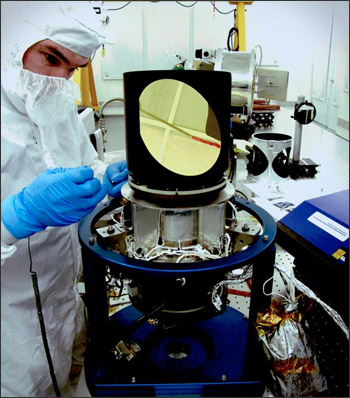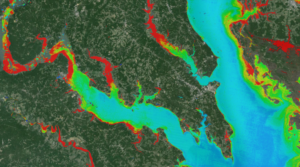Special Topics: LDCM and LDCM Components

The Scene Select Mechanism is an apparatus that rotates the LDCM Thermal Infrared Sensor (TIRS) mirror among three scenes: the Earth view (“nadir;” when imaging the Earth), and two calibration views (one of a warm blackbody carried onboard and the other of a deep-space cold view). The Earth view requirements for instrument pointing are very stringent, correct image positioning depends on precise pointing and that position must be returned to faithfully after each calibration sequence. The requirement for the Thermal Infrared Sensor (TIRS) is to image up to 44 minutes continuously, which corresponds to the longest uninterrupted landmass pass that TIRS needs to image before traveling over water—when the calibration sequence can be performed again. (This long-land path curves from Northern Russia to the southern tip of Africa.)
Bunny suit: The TIRS instrument is kept in a cleanroom and anyone working on it must wear cleanroom clothing that minimizes particulates coming from a person’s clothing. Prior to entering the cleanroom, each person also takes an “air shower” which blows any excess dust off of them before entering the cleanroom. Inside the Class 10,000 cleanroom are filters which continuously filter the air inside to ensure there are no more than 10,000 particles greater than 0.5 microns in size within a cubic foot of air (the average home has about 300,000 particles per cubic foot).

Be Part of What’s Next: Emerging Applications of Landsat at AGU24
Anyone making innovative use of Landsat data to meet societal needs today and during coming decades is encouraged to submit and abstract for the upcoming “Emerging Science Applications of Landsat” session at AGU24.





